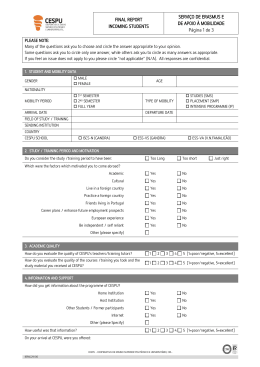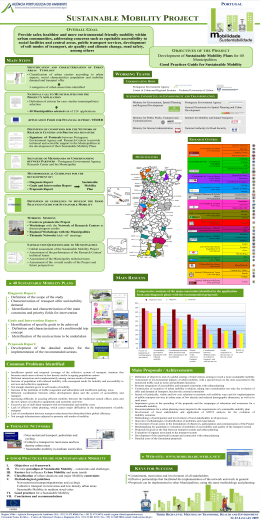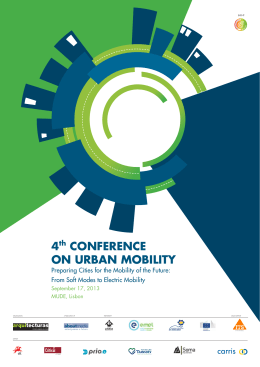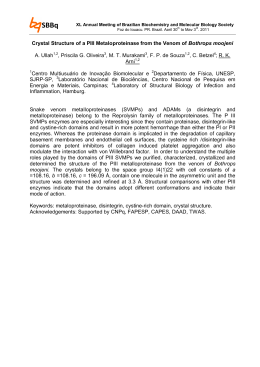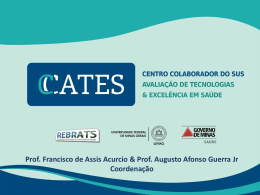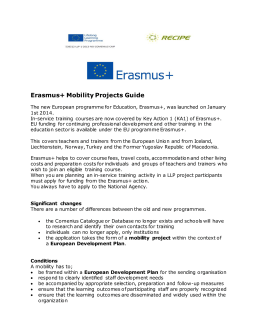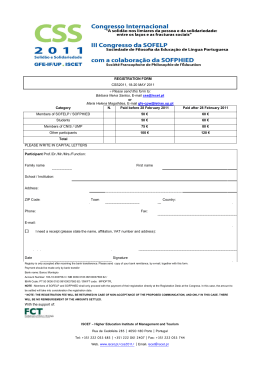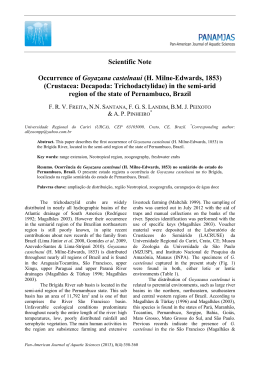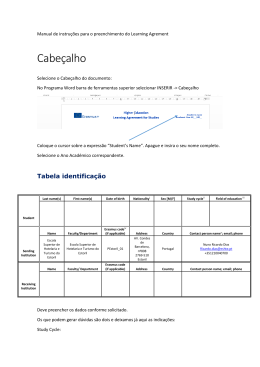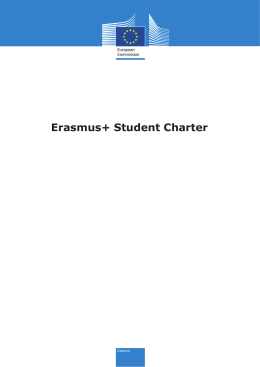TELEOLOGICAL FRAMEWORK FOR TRANSPORT PLANNING AND EVALUATION: A TOOL IN THE SEEK FOR INTEGRATED AND MEANINGFUL SOLUTIONS FOR BETTER RESULTS Marcos Thadeu Queiroz Magalhães Luís Sérgio da Cruz Silveira Ernesto Pereira Heider Augusto da Silva Thaís Maria de Andrade Yaeko Yamashita Joaquim José Guilherme de Aragão Centro de Formação de Recursos Humanos em Transportes da Universidade de Brasília – CEFTRU/UnB e Programa de Pós-Graduação em Transportes – PPGT da Universidade de Brasília INTRODUCTION On what concerns to the Thredbo Forum discussions´ perspectives, Hensher (2007) presents a couple of challenging thoughts which are related to different levels of the current praxis. These thoughts bring into the spotlight both methodological and application levels, and try to point a brand-new (or, maybe, a not-so-brand-new) perspective for transport studies and practice. On highlighting directives as such: (i) design products for the right role; (ii) differentiate on the basis of service and not mode; and (iii) design from the results backwards, Hensher (2007) turns the current practice upside-down in the seek for better and effective results from transport planning and practice. When results are put in first, we assume, at least unconsciously, there is a teleological drive on transport issues. By “teleological drive”, we mean that something has a reason, a purpose by which it is determined and shaped. Gigch (2002) supports the teleological approach as being fundamentally related to social/human sciences. In this sense, the very nature of transport science is put into doubt, at least to some scientific communities that fundamentally take it for natural science. The consequences are deeper than imagined on first-thought. It implies a change on traditional vision that shatters transport into specific and sometimes “exclusive” technologies without seeing (or seeking) the required synergy the different transport solutions should constitute. That change of perspective has become a necessity as complexity of transport phenomena increases. In this paper, we accept Hensher´s challenge by trying to build a objective-oriented (teleological) framework for transport planning that could: (i) establish a set of results which have to be sought by the transport sector; (ii) not be mode oriented, thus allowing an inclusive solution approach; and (iii) restrict results to what can be expected from transport planning and practice. This framework starts from classic and commonly accepted objectives as Mobility, Transport Efficacy and Efficiency to specify main issues that contribute to each of these aspects. This framework is also a powerful tool on designing information and decision support systems, structuring a knowledge-base, and on designing strategies on transport improvement in order to deal, among other issues, with the problem of social exclusion. SUPPORTING THE TELEOLOGICAL APPROACH TO TRANSPORT STUDIES The strong technological bias of Transport Studies is well-known. It was born in the cradle of Engineering, and most of its development came from that field of research. For a long time it seemed enough, even though, from time to time, few observations pointed out problems with theories and fundamentals that served as base to scientific and technological research in the area (Vasconcellos, 1996, Burden, 2001). Despite the appointed issues have been persuasive, they were disregarded, or put into ‘standby’, as results achieved by the traditional engineering approach were useful to practical purposes. According to Kuhn (1970), this period is called ‘normal science’ and it’s strongly supported by a paradigm widely accepted by the scientific community. In time, these observations led to the idea that the Transport field was not an isolated engineering sub-branch, but a multidisciplinary field of studies. On this new paradigm, transport became a much more complex phenomenon that required new different approaches. (Vasconcellos, 1996, Burden, 2001) When the old paradigm was put into doubt, and more and more researchers started to seek for new ones, the Transport Studies field entered in a state that Khun (1970) called ‘Scientific Revolution’. In the last decades, few candidates to paradigm have emerged and vanished, and we have not yet come to consolidate a new one. In this period, different branches of studies have emerged, ie. Transport Geography, Sociology, Psychology, Planning, Regulation etc. Each one has specific approaches but lacking integration with each other. We point out the duality natural vs. social science that is still not solved in the Transport field of studies as one of the reasons for this. As a proposal, we will support that Transport Studies are more suitable to social sciences than to natural sciences, as we understand this as a more useful approach into integrating meaningfully the branches of Transport Studies. Social vs Natural Sciences: Which one is more suitable? In order to proceed to the proposal of this paper, the nature of transport studies must be addressed. Here, we will support that transport sciences is more suitable to social sciences domains than to physical’s. For that, this section brings two different points of view into perspective: one of natural sciences; and other of social sciences. These distinctions are presented by Gigch (2002a And 2002b). Knowledge Characteristics Physical science domains Social science domains Characteristics and properties of domains Closed systems without behavioural characteristics Open systems with biological and behavioural characteristics. Non-Behavioral or goal-seeking Purposeful and goal-seeking Mathematical theories and models Heuristic modelling Empirical inferences and results Empirical inferences and results Objectivity: external world independent from observer Objectification: ‘free knower from practices which produce him’ Sources of representation Concept of knowability knowledge reality and and Subjectification: ‘search evidence dominated by power’ Act of knowing: No external reality separate from knower. Description, prediction causality and Logical relationship between premises and conclusions Logical relationship between premises and conclusions Only statistical links between causes and effects Measurement and precision Uncertainty principle Statistical links between cause and effects Truth value and guarantor Value of metalogic Judgments may be value-laden and create an obligation. Importance of consequences on recipients Figure 1. Differences between Physical science and Social sciences domains. Adapted from Gigch (2002a and 2002b) According to Figure 1, one difference between physical and social sciences domains is that the later is purposeful and goal-seeking. This means that for each phenomenon there is a purpose, intention, a goal that determines its existence. On recent studies, this characteristic has been increasingly related to transport. When Hensher (2007) points out the need to design transportation systems from results backwards, he takes this principle into account. Also, the intuitive notion that transport happens to fit individuals and social needs corroborates with this same notion. Furthermore, when every OD survey collects data about the purpose of each trip (ie work, study, leisure etc) in order to estimate demand for transport services, it assumes that transport has a reason to happen. About knowledge representation, physical sciences domains only work with mathematical models, while social sciences domains also uses heuristic models to represent reality. Traffic engineering, maybe one of the most math-driven fields on transport studies, has been using heuristic modelling for a long time since. It has even included artificial life models (ie. Cellular Automata) to simulate different traffic phenomena. Finally, about the concept of truth, social sciences recognize that judgments and consequences on recipients are very important, and it’s normally related to what is taken as true or false, useful or not. On transport studies and practice, the formalization of the so-called ‘adequate service’ (Magalhães et all, 2007) bounds together the goal-driven characteristic and the importance of judgement and consequences on recipients. Thus, moral issues and subjective factors are important to transport studies. Based on the arguments presented on this section, we sustain that Transport is more suitable to social sciences domains issues and methods than to physical sciences domains’. And here, we agree with Hensher (2007), and stress the teleological (objective-oriented) approach to deal with transport issues. KEY-CONCEPTS AND DEFINITIONS TO TRANSPORT TELEOLOGICAL FRAMEWORK DESIGN In order to develop a teleological framework, key-concept and definitions must be set. This will provide a common-ground to the discussion that follows. Transport as Intentional Phenomenon Otherwise we might think, the definition of transport is not consensual. If a couple of transport technicians were to be asked ‘what is transport?’, the answer would probably differ from one and other. Some books define transport as ‘movement of people and goods’ (Morlock, 1978). Other papers define transport by some of its characteristics, but it is not a definition. As consequence, transport studies sometimes fail on clearly defining its object, and many times invade other fields of study by claiming their multidisciplinary character. On first sought, it would not be a problem as it could be interpreted as a widening of the current vision and theories to better deal with transport problems. But, as it fails on clearly defining its object, the field of study ends up mixed with other fields and losing its identity, which is not good. So it is necessary to state ‘what transport is’, and thus ‘what it is not’, in order to properly develop the teleological framework intended here. As presented on the previous section, the goal-seeking and purposeful characteristic of transport is recognized, even in a non-conscious fashion, on many specialized papers and works (Magalhães et al, 2007). And so, this intentional property is a key-factor to distinguish what transport is amongst different kinds of movements. Figure 2 presents a simplified taxonomy of movements. Figure 2. Simplified Taxonomy for Movements In Figure 2, movements are divided into two main branches: non-intentional and intentional movements. Non-intentional movements are those whose reason cannot be observed. It is not possible to answer the question ‘What does this happen for?’. Examples of this kind of movements are: water flow, movements of planets, a falling rock, etc. These phenomena are object of physical sciences. Intentional movements are those whose reason is possible to be observed. Note that, “to be possible to observe” do not implies ‘it is easy to be done’. In general, it is a very complex task to map a reasoning chain and to identify all the agents involved. Examples of these movements are: flow of communication, energy transmission, movements of people and goods, etc. In this case, transport is the intentional movement of goods and people. As previously referred, social sciences domains have purposeful and goal-seeking nature, to what theories and tools used on the physical sciences domains are far from enough. And, being so, the development of a teleological framework becomes coherent and useful. General Transport Semantic Structure As intentional nature of transport is accepted, some implications must be observed. Some points must be highlighted: • • • • • • transport is an action, and so, there must be a subject and an object; the intention that guides transport is the subject’s intention; the transport object is what is needed to satisfy subject’s needs; the subject itself does not necessarily carries the object; the relation between subject and object in the transport process is mediated; the transport happens in a context, which influences and is influenced by transport. Given that, a general transport semantic structure is presented below (Figure 3). Figure 3. General Transport Semantic Structure Observing the provided structure, the following points can be depicted: • • • • • • • Transport has a purpose, a goal; The act of transporting involves a subject and an object; The relation between the subject and the Object is mediated by the means of transport; The Subject needs the transport of the Object in order to satisfy its needs; The Subject activates the Means of Transport (understood as a ‘tool’); The Means of Transports moves the object, according to Subject’s instructions; A Transport System is an instance of the Means of Transport. Now, the definition of transport objectives is needed in order to build a tool for transport planning and evaluation. The Core Transport Planning Objectives The limits of the results that can be expected from transport planning must be made clear, if an objective-oriented approach is adopted in Transport Planning. Otherwise, someone could establish commitments that could not be achieved by transport initiatives: for example, one could set local economic development, or even life quality improvement, as a result for a transport project or plan. It is clear that these results need multisectorial initiatives and synergy. In other words, results must be compatible with the power of action, and the results must also be socially relevant. What is sought here is the building of a teleological framework that could help both planning and evaluation processes. By defining a set of coherent results that can be (and should be) expected from transport planning, it becomes more effective and efficient. This happens as problems become more clearly identified, and the corresponding actions are better developed. Now, core-results from transportation planning must be set. The most common results/objectives related to Transport Planning are (TCRP, 2004;Hensher, 2007; Magalhães et al,2007; Vasconcellos, 1996). • • • • • • • • Accessibility; Efficacy; Efficiency; Availability; Safety; Security; Mobility; Reliability. Although these objectives are quite frequent on the existing bibliography, the extension of each of these concepts is poorly defined. This allows superpositions to occur. Yet, many of these concepts are categorically connected (composition connection or a causal/deterministic connection) but the relationships among them are not clear. The framework proposed starts with 3 core-objectives for transport planning: (1) Mobility; (2) Efficacy; and, (3) Efficiency. Each one of them will be further detailed in the next section, along with the explanation of the teleological framework. THE TELEOLOGICAL FRAMEWORK Pre-Requisites for Understanding the Framework In order to develop the framework, the general transport semantic structure was taken as a start point. On the transport process (Figure 4), it is required to understand that: • • • • • Transportation planning actions can be designed to change either the Transport Subject, the object or the means of transport; The decision for transporting or not is a Transport Subject’s decision; The Means of Transport are what move the Object from one place to another; The Means of Transport are what determines the efficiency of the process; Subject and Object are outside the Means of Transport; Teleological Framework Level 0: The Core-Objectives Three different aspects were chosen as core-objectives: (1) Mobility; (2) Efficacy; and, (3) Efficiency. The relationships among them are presented below (Figure 4). Figure 4. Teleological Framework Level 0: Core-Objectives First, Figure 4 can be read as follows: • • • Transport planning changes transport conditions; Transport Planning has objectives; Transport Objectives are: mobility, transport efficacy and transport efficiency. Mobility is the capacity of something to be transported (Magalhães&Yamashita, 2006). Thus, this is an Object’s property, not Subject’s. However, it depends on properties of the Subject, Object and the Means of Transport (henceforth, just referred as ‘transport system’). Next, this concept will be further detailed. Transport Efficacy means that, when transport happens, it is successful. In a theoretical ideal state of mobility, every single object (people or goods) can be transported when needed. However, this does not mean the transport process is successful. This idea of success on transport process is related to the term ‘efficacy’. Later in this text, this definition will be detailed. At last, Transport Efficiency follows the classic definition of efficiency, and means the transport process provides maximum products with minimum inputs. In a hypothetical situation, there could be mobility and efficacy, but no efficiency at all. This final dimension tries to guarantee that the process is the best possible. Teleological Framework Level 1a: The Mobility Objective As previously referred, mobility is the property of the objects that can be transported. In the transportation process the relationship between the Transport Subject and the Object is mediated by the Means of Transport. Thus, accessibility must be considered in two different dimensions: the Subject’s accessibility to Means of Transport and Object’s accessibility to the Means of Transport. By definition, the Transport Subject is the agent that needs the displacement of the Object in order to satisfy his/her needs (here, the specification of ‘needs’ is not relevant). The Subject activates the Means of Transport in order to achieve the desired results (the transportation of the Object). The Means of Transport are tools used by the Transport Subject in order to move the Object. It is composed of agents, procedures, equipments, and other elements. The Transport Object is what is displaced in the transportation process. Given that, accessibility can be generally defined as the possibility of a relationship to happen. Thus, Subject’s accessibility to means of transport is the possibility of the means of transport to be activated by the Subject. Issues that could affect this accessibility are: payment capacity, product’s market competitiveness, temporal availability of the services, etc. On the other hand, the Object’s accessibility to Means of Transport is the possibility the means of transport to move the object in an adequate fashion. Determinant factors to this kind of accessibility are: spatial availability of transport services, transportation system-object compatibility (including comfort issues), system capacity and others. Figure 5. Teleological Framework Level 1a: The Mobility Objective In order to provide mobility conditions, the transport planner has to focus on these two dimensions of accessibility. However, mobility provision is not enough to provide what we could call ‘good transport’. This is because mobility only grasps the possibility for transportation to happen. So, its effective accomplishment is not covered. This is why the next dimension is important: the Transport Efficacy. Teleological Framework Level 1b: The Transport Efficacy Objective As previously seen, the Mobility Objective guarantees that the transport can happen, but this does not assures it is well done. The Transport Efficacy Objective puts this concern into grasp. ‘Good transport’ is, beyond mobility issues, the one which: has tempestivity; maintains object’s integrity; and is assertive. By definition, Tempestivity is the property of the transport that happens on time. Punctuality issues are related to this factor. In other words, opportunities may be missed if a trip doesn’t happen on the programmed time schedule, and so, transport loses it effectiveness (to satisfy, or to help satisfying, subject’s needs). That’s why this factor is important for efficacy evaluation. The second issue is the Object’s Integrity. ‘Good transport’ does not damage what it carries, be it cargo or people. So, Object’s integrity is the maintenance of transport object’s properties during the trip. This is a requirement to which transport must comply. This concern involves transportation safety and security, both common issues on any transportation plan. Otherwise, one could evaluate the transport during which people die, or get hurt, as effective, and this is counterintuitive. Finally, transport must take an object from the origin and take it to the right destination. This property is called Assertivity. It is an intuitive notion that transport has to move the object from a specific origin to a specific destination. When this does not happen, it is assumed that the cargo got lost in the process, and the user does not get satisfied. Again, this last point is also important to Efficacy’s evaluation. Figure 6. Teleological Framework Level 1b: The Efficacy Objective The efficacy issues complied, we get to the last dimension: Transport Efficiency. In a transport context, it is possible to have mobility, the transport may be effective, but the process could be inefficient. Because of that, in order to achieve a good transport condition we assume that efficiency conditions must be also be met. Teleological Framework Level 1c: The Transport Efficiency Objective The last objective aimed by transport planning is Efficiency. As this is a very broad concept it must be further detailed to make it possible to have any operational meaning and utility. The general concept of efficiency is the provision of maximum results/products/output with minimum resources/inputs. In this sense, this concept seems to be restricted to the production process. However, when dealing with transport (and other economic activities) efficiency effects are only broadly perceived when market efficiency is achieved. So, it is proposed that, on dealing with transport it is required to address both market’s efficiency and production efficiency. Transport Market Efficiency is deals with the competitiveness of transport services. It could include: service prices (both for transport services and infrastructure ones); market structure and regulation, amongst other issues. Transport Production Efficiency is the provision of maximum transport with minimum resources. This concept was also widened to grasp environmental issues. So, it must include: transport services’ production costs; infrastructures’ production costs and environmental externalities. If both these objectives are achieved, it is possible to say there are efficient transport processes. Along with the other two objectives previously referred, it is possible to achieve a ‘good transport’ state. The benefits and application of this approach are presented in next section. Figure 7. Teleological Framework Level 1c: The Efficiency Objective BENEFITS AND APPLICATIONS The adoption of a teleological framework can bring different benefits to transport planning activities. Some of the benefits and applications of the teleological framework are: • • • • • • • Structuring transport analysis and planning; Defining issues to build a diagnostic; Providing a scope of themes for database modelling; Indicators development; Planning programs and evaluation; Information system design; Bringing public and technicians closer, as it deals with socially sensible results; etc. Despite listed in a general fashion here, the benefits provided by this framework are already being observed in its application to the development of an Indicators Systems for Government’s Transportation Programs in Brazil. This project is to be finished and conclusive material is yet to be produced. This structure was also tested on a Planning Workshop, along with the Transportation Ministry in Brazil, whose objective was the development of the new sectorial Plan for 20082011. All the results provided are yet to be implemented. Other applications in progress are: Data Warehouse specification; Transportation Information Systems; and OLAP dimension design (including prototype). FINAL COMMENTS AND FURTHER RESEARCH The main issue on adopting this structure is to assume the teleological drive of the transport studies field. As presented earlier, many researchers have provided elements that support this argument, even on a non-systematic manner (Hensher, 2007, Burden, 2001; Magalhães et al (2007); Vasconcellos, 1996). Although the framework has already provided results, further research is still needed. For example, each objective (mobility, efficacy and efficiency) and its sub elements must be detailed and specified. Restriction of each concept will help to develop a more clear scope for database development, indicators development, and performance evaluation. Special attention should be dedicated to Transport Efficiency that includes market efficiency and transport production efficiency. Another problem that must be addressed is the lack of a transport framework: ontology of transport. This should constitute a primary structure for development of a knowledge base for integrating different research and practical initiatives. Benefits would vary from better knowledge and information dissemination through comprehensive modelling of reality. This ontology should be comprehensive enough to be compatible with both macro and micro scales, and ready to be coupled with other related ontological models. Finally, the teleological framework comes as an answer for Hensher’s challenge (Hensher, 2007) to plan and build transport systems from the results backwards. That’s what it is: a set of meaningful and socially relevant issues and objectives to what transportation must comply in order to satisfy the needs that determine its existence. REFERENCES Burden, Dan (2001). Building Communities with Transportation (Lecture). Transportation Research Board, Washington. Gigch, John (2002a) Comparing the Epistemology of Scientific Disciplines in Two Distincts Domains: Modern Physics versus Social Sciences. I. The Epistemology and Knowledge Characteristics of the Physical Sciences. In System Research and Behavioural Science Journal. Whiley Intersciences. Gigch, John (2002b) Comparing the Epistemology of Scientific Disciplines in Two Distincts Domains: Modern Physics versus Social Sciences. II. Epistemology and Knowledge Characteristics of the ‘New Social Sciences’. In System Research and Behavioural Science Journal. Whiley Intersciences. Hensher, D. A. (2007) Looking forward: What comes next in competition and ownership of land passenger transport? In Macario, R. (ed.) Competition and Ownership in Land Passenger Transport: Selected Papers from the 9th International Conference. Elsevier, Oxford, Chapter 2. Khun, Thomas (1970). The Structure of Scientific Revolutions, 2nd ed, Chicago University, Chicago. Magalhães, M. T. Q.; Yamashita, Y.; Teixeira, G. L.; Luís G. P. L. Carneiro (2007). Development of an Indicators System for Quality Management of the Interstate and International Coach Transportation Service in Brazil. In Macario, R. (ed.) Competition and Ownership in Land Passenger Transport: Selected Papers from the 9th International Conference. Elsevier, Oxford Magalhães, Marcos T. Q. &Yamashita, Yaeko (2006). Definição de mobilidade: uma abordagem crítica na delimitação do conceito. In Mendes at all (Ed.) Pluris 2006. Anais do 2oCongresso Luso Brasileiro para Planeamento Urbano Regional Integrado e Sustentável. Braga. Morlock, E.K. (1978) Introduction to transportation engineering and planning. New York, McGraw Hill. TCRP (2004) Improving public transit options for older persons Transit Cooperative Research Program Report 82, Vol. 1 and Vol.2. Vasconcellos, Eduardo A. (1996) Transporte urbano nos países em desenvolvimento: reflexões e propostas. Editoras Unidas, São Paulo.
Download
